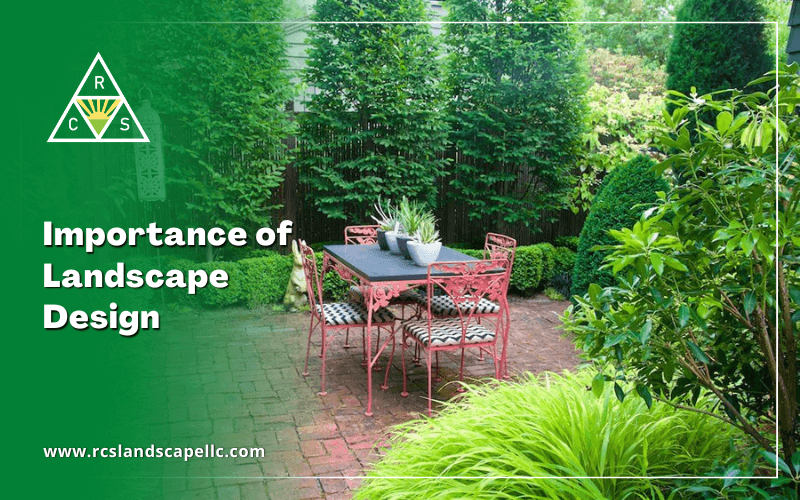All About Landscape Design
Wiki Article
The smart Trick of Landscape Design That Nobody is Discussing
Table of ContentsLandscape Design for DummiesWhat Does Landscape Design Mean?The Landscape Design StatementsSome Known Incorrect Statements About Landscape Design
Formal style theme. Credit: Gail Hansen, UF/IFAS The backyard is an extension of the home where a variety of tasks occur. A lawn can normally be divided into 3 areas: public (the front yard), private (the backyard), and service (usually the side lawn). The place of task areas depends mostly on the kind of area, the size of room required, the kind of activity, and the preferred closeness to various other activities and frameworks (Landscape Design).
The outdoors wall surface of your home usually offers as the initial wall surface or starting factor of an outside area. Inappropriate uses should be divided, and associated activities, such as food preparation and dining, ought to be assembled to make the backyard a lot more effective and satisfying. When making use of hardscape to create rooms, utilize building and construction product comparable to that made use of in your home for continuity from your home into the garden.
Linked spaces. Credit History: Gail Hansen, UF/IFAS Using comparable hardscape features and repeating plants draws the eye around the garden.
From a design perspective, plant materials have three major functions in the landscape: visual, architectural and utilitarian. Aesthetically, plants produce an aesthetically enjoyable setting and structurally plants arrange and specify areas.
Some Known Questions About Landscape Design.
For psychological comfort plants are utilized as physical or suggested obstacles for personal privacy and safety and security. Physical obstacles obstruct both the view and access to a space and consist of fencings, walls and plant bushes. Landscape Design. Implied barriers, normally low expanding plants, obstruct access but not the view (Number 9). Other functions of plants consist of cleaning up the air, avoiding disintegration and dirt loss, retaining moisture in the dirt, and returning raw material to the dirt.Physical and suggested barriers. Credit Score: Gail Hansen, UF/IFAS For these reasons, the types of plants to be used (such as trees, bushes, or groundcovers) should be picked in the onset of preparation. Plant types are picked for their functional abilities to ensure that their future objective and called for area can be thought about at the exact same time.
The overhead plane, the vertical airplane and the ground aircraft need to all be thought about to create enclosure. As soon as the shape of a plant bed has been developed, the plants should be massed (grouped) and layered to achieve aesthetic unity and the wanted amount of enclosure. The dimension of a plant mass will certainly depend on the overall size of the yard, the size of the individual plants in the mass, and the focus or influence wanted from the plant material.
Each plant mass is in front of, behind, or following to, one more mass. Credit Rating: Gail Hansen, UF/IFAS Repeating plants within a mass and duplicating masses with similar plants ties the garden together. The specific plant characteristics have to be considered to successfully layer and mass plants.
4 Simple Techniques For Landscape Design
All plant make-ups begin with the primary structure plants, the huge, mostly evergreen background plants-such as the trees and large hedges. These plants separate or enframe areas, control the size of the area, and provide the starting point for choosing the ideal attributes of the second layer, midground plants, for massing and infill.
Important points in the garden need to be highlighted by the use of one-of-a-kind plants, distinctive frameworks, or yard ornaments. Marking thresholds or entrances to areas can be finished with gates, arbors, and steps, or with using unique and vivid plants. The kind and/or style theme of the yard will typically assist figure out the important factors and just click here for info how they should be highlighted.
Various other important places in the yard are focal factors, which is used to visually arrange a designed location. Various perspectives or point of views can reveal different compositions in the landscape that might require a range of focal points.
The Only Guide for Landscape Design
Figure 13. Plant kinds. Credit: Gail Hansen, UF/IFAS After form, structure is the next leading attribute of a plant; crude, medium and fine structures can be made use of for comparison and browse around this site emphasis in the landscape. Kind and texture both trump shade in the yard for most of the year. Throughout certain seasons, shade will certainly be the most visible attribute of the garden.

The pleasant scent of plants, the noise of wind in the trees, the audio and texture of water, and the colors and appearances of sculptures, pots and garden furniture all contribute to the experience of the garden. One detail that is typically ignored is the effect of light on the aesthetics of the plants.
The entire yard modifications in feature and look throughout the day, and the training course of a year, as the light and temperature modification from early morning to evening and season to season. Plant selection should consider a plant's development price, its mature dimension and form, and the upkeep it will useful link certainly need.
It is essential to recognize the eventual fully grown dimension of plants so they can be placed in the right location and spaced effectively when they are set up. Providing plants area to grow is a difficulty due to the fact that the common fully grown size is commonly based on optimum growing problems and the environmental conditions of a site may trigger a plant to expand larger or remain smaller.
Report this wiki page